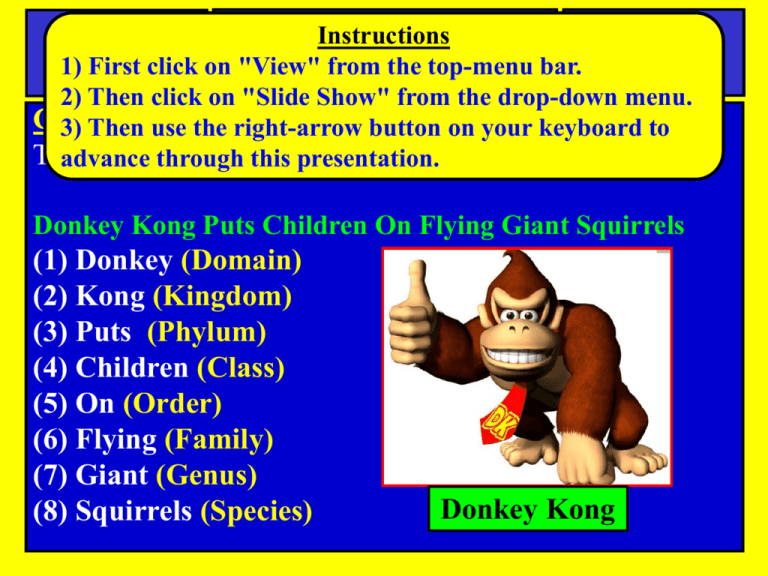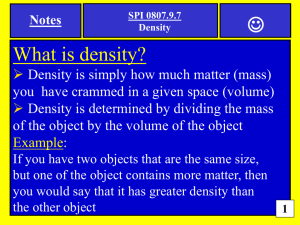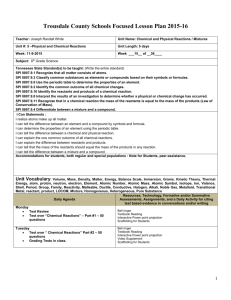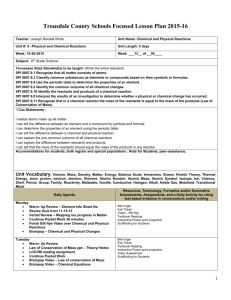Notes-Classification Keys
advertisement

Bell Instructions SPI 0807.5.1 1)Work First click on "View" from then top-menu Classificatio Keys bar. Science 2) Then click on "Slide Show" from the drop-down menu. Copy down 3) Then usethe the following right-arrowlist. button on your keyboard to This is a memory for the 8 levels of classification advance through device this presentation. Donkey Kong Puts Children On Flying Giant Squirrels (1) Donkey (Domain) (2) Kong (Kingdom) (3) Puts (Phylum) (4) Children (Class) (5) On (Order) (6) Flying (Family) (7) Giant (Genus) (8) Squirrels (Species) Donkey Kong Notes SPI 0807.5.1 Classification Keys Science Tennessee SPI Objective: Use a simple classification key to identify an unknown organism. Essential Learning Students will identify unknown organisms using classification keys. Essential Question How do I interpret and use the information in a classification key to identify an unknown organism? Notes SPI 0807.5.1 Classification Keys Science Tennessee GLE Objective: Identify various criteria used to classify organisms into groups (Discuss) Tennessee Check for Understanding: Select characteristics of plants and animals that serve as the basis for developing a classification key (Discuss) What is taxonomy? Taxonomy is the science of defining and naming organisms. Organisms are classified according to similar physical and genetic characteristics. Notes SPI 0807.5.1 Classification Keys Modern Taxonomy: 8 level system of classification Categories go from broad to narrow 1) Domain 2) Kingdom 3) Phylum 4) Class 5) Order 6) Family 7) Genus 8) Species Science Notes SPI 0807.5.1 Classification Keys Science 8-level classification system Similar Example: Where is Rock Springs Middle School? 1) The Universe 2) Milky Way Galaxy 3) Planet Earth 4) Northern Hemisphere 5) North America 6) The United States of America 7) Tennessee 8) Smyrna Notes SPI 0807.5.1 Classification Keys Science Classification Criteria In taxonomy organisms are classified according to similar physical and genetic characteristics. Example 01: At the Domain level -organisms are classified according to whether or not their cell(s) contains a nucleus. Prokaryotic Cell (no nucleus) Eukaryotic Cell (has a nucleus) Notes SPI 0807.5.1 Classification Keys Science Classification Criteria In taxonomy organisms are classified according to similar physical and genetic characteristics. Example 02: At the Class level -organisms are grouped according to similar physical characteristics. Classes of Animals Notes SPI 0807.5.1 Classification Keys Science What is binomial nomenclature? Around 1735 Carolus Linnaeus created a system of naming organisms called binomial nomenclature It is a two part naming method Uses the last 2 classification levels (Genus and Species) to name an organism Example: Human Beings Genus: Homo Species: Sapiens SPI 0807.5.1 Classification Keys Notes Science 8-level classification system Example: Human Beings (Homo Sapiens) 1) Domain: Eukarya 2) Kingdom: Animalia 3) Phylum: Chordata Binomial Nomeclature 4) Class: Mammalia 5) Order: Primates 2 part naming system 6) Family: Hominoidia 7) Genus: Homo 8) Species: Sapiens 1st part 2nd part Notes SPI 0807.5.1 Classification Keys Classification Keys There are different types of classification keys. Here is one example you might see on a quiz or test. Science Notes SPI 0807.5.1 Classification Keys Science Classification Keys There are different types of classification keys. Here is another example you might see on a quiz or test. Notes SPI 0807.5.1 Classification Keys Science Classification Keys There are different types of classification keys. Here is another example you might see on a quiz or test. Notes SPI 0807.5.1 Classification Keys Science Classification Keys There are different types of classification keys, but now we will focus on dichotomous keys. What is a dichotomous key? It is series of paired questions which help you identify an organism. Example: (for identifying species of bears) 1a. It has white fur------------------species: Ursus maritimus 1b. It does not have white fur-----Go to step two 2a. It has brown fur-----------------species: Ursus arctos 2b. It doe not have brown fur-----Go to step three 3a. It has black fur------------------species: Ursus americanus 3b. It doe not have black fur-------Done Video Link: Dichotomous Key Tutorial Activity SPI 0807.5.1 Classification Keys Science Classification Key Activity T.Rex Dichotomous Key) Stegosaurus (A.K.A: Pterodactyl Apatosaurus After reviewing the following you will make a dichotomous key Here is an example using four dinosaurs Steps Dinosaur Dichotomous Key A. It has wings It is a Pterodactyl 1 B. It does not have wings Go to step 2 2 A. It walks on two legs B. It does not walk on 2 legs It is a T.Rex Go to step 3 3 A. It has a long neck B. Does not have a long neck It is a Apatosaurus Go to step 4 4 A. It has spikes on its back B. Does not have spikes It is a Stegosaurus Done Activity Ankylosaurus Activity Make a dichotomous key about these 7 organisms Velociraptor Apatosaurus T.Rex Spinoaurus Pterodactyl Stegosaurus








